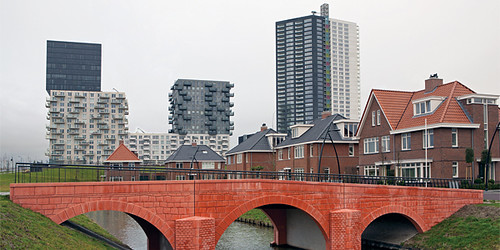
PREV ARTICLE
NEXT ARTICLE
FULL ISSUE
PREV FULL ISSUE
THE EURO ZONE'S BRIDGES FROM NOWHERE
I came across this interesting item in Bloomberg BusinessWeek.
Usually life imitates art in banknote design, but in this case it's the other way around.
-Editor

Those bridges on the back of euro notes were conceptual-until a rebellious Dutch designer got to work. in the fall of 2009, Robin Stam was waiting to pay for his dinner at Angelo Betti, a busy pizzeria close to his house in Rotterdam. Sitting at his table, he noticed for the first time the series of small bridges that appeared on the back of his euro notes. A young graphic designer with a jagged mop of brown hair, Stam began to research how the drawings ended up on the back of the euro. The bridges were designed by Robert Kalina, an employee of the National Bank of Austria in the mid-'90s, as a tribute to European engineering. When Stam, who has a rebellious streak, learned that the structures didn't exist, he decided to change that. He would build the bridges for the first time in his hometown, the humdrum Rotterdam suburb of Spijkenisse. "They chose bridges on the euro notes to symbolize communication between the countries," Stam explained in December, sitting in studio space he rents with two friends in Hoogvliet, another suburb on the edge of Rotterdam. "Well, that didn't work out." Kalina's bridges beat out more than 40 other designs in 1996 because, among other factors, they were totally uncontroversial. Each euro note's bridge represents a different European architectural epoch: classical, Romanesque, Gothic, Renaissance, Baroque and Rococo, industrial, and 20th century modern. The higher the denomination, the more recent the style. When the euro crisis started brewing, Stam set to work bringing the bridges, those woebegone symbols of European cooperation, to life. "I thought it was funny that me, just a regular designer, could take something that big and just claim it," says Stam, who is 30. His plan was to build the bridges exactly as they appear on the back of the bills, down to the pastel colors, which would enliven his drab portside suburb. Partly for a laugh, Stam mentioned the idea of building the bank-note bridges to Spijkenisse Alderman Gert-Jan't Hart, who manages new construction projects on the city council. "I thought that was a brilliant idea," Hart says. "Every European citizen and every member of the European community who has the biljet in their hands will have a link to Spijkenisse." The town happened to be in need of a set of bridges to support car, bicycle, and pedestrian traffic over a creek surrounding a new middle-class housing development, Het Land (the Countryside). "We already reserved the money in our budget for six bridges," Hart says. Because the development needs six and not seven bridges, two of the seven bank-note bridges,the €5 classical and €20 Gothic bridges, are being built as a split-personality 20-meter-wide dam. The entire project will cost Spijkenisse roughly €1 million ($1.29 million). "The euro bridges are, let's say 25 percent more expensive, but all the attention is more than worth it," says Hart.
To read the complete article, see:
The Euro Zone's Bridges from Nowhere
(www.businessweek.com/magazine/the-euro-zones-bridges The Numismatic Bibliomania Society is a non-profit organization promoting numismatic literature. See our web site at coinbooks.org. To submit items for publication in The E-Sylum, write to the Editor at this address: whomren@gmail.com To subscribe go to: https://my.binhost.com/lists/listinfo/esylum All Rights Reserved. NBS Home Page Contact the NBS webmaster 
|